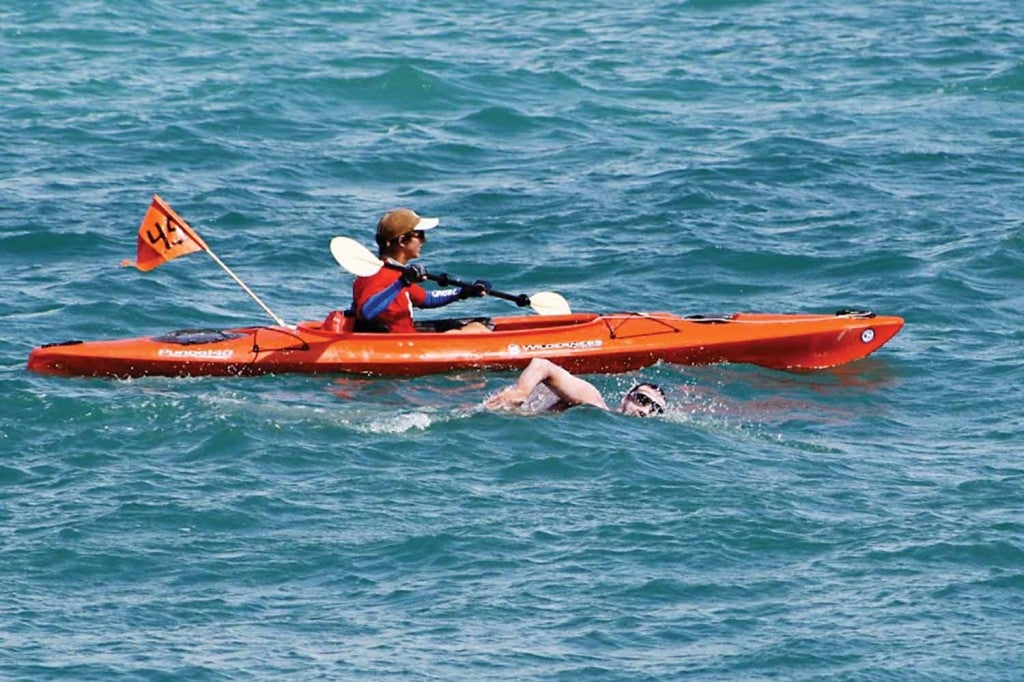Gain Confidence By Training For An Endurance Swim

Photo: Dan Sweeney
Gain confidence in the open water by training for an endurance swim.
Run a marathon or ride a century? Those are common single-sport pursuits for multisport athletes. But what about swimming a 10K? Few triathletes take on a long-distance, open-water swim. Perhaps it’s because no triathlon, even the Ironman, has an ultra long endurance swim. Maybe it’s because a lot of triathletes don’t consider themselves strong swimmers. But it’s time triathletes gave distance swimming a chance.
Endurance swims, often called marathon swims, are held in anything from rivers to oceans. Many distances are dictated by the challenge: It’s 12.5 miles to swim around Key West, or eight miles to swim around the Boston Lighthouse. Others are simply set distances, mostly ranging from six miles to longer than 30. These are certainly distances that would challenge any athlete, but a challenge is what endurance racing is all about, right? Taking on a big swim could even improve your triathlon time. Here’s how.
First, there’s the time. When I started racing triathlons I took coach Matt Fitzgerald’s advice that to be a better runner you might want to become a runner for a while. The same theory applies to the marathon swim. There will be no assistance from a wetsuit (most marathon swims don’t allow them regardless of the water temp). In training for a marathon swim you have no choice but to become a decent swimmer.
Second, if you’re going to be a swimmer, you should be an open-water swimmer. “Swimming in a pool is like running on a treadmill,” says Total Immersion Swimming coach Lloyd Henry. “You can gain fitness there, but it’s different being on the open road.” Laps in a pool, a Masters swim program—those are great ways to build skills, but your swimming will have to adjust to the open water. By taking on the challenge of a marathon swim you will be forced to spend more time training in open water, which will give you the confidence for any triathlon swim.
So you’re inspired to sign up and get training? The Marathon Swimmers Federation maintains a calendar of races (Marathonswimmers.org), and as with triathlon, it’s best to start with a shorter distance and work your way up. (Some major races require a qualifying swim of at least 2.4 miles.) Also, be sure the average water temperature is one with which you’re comfortable. Most races also require a pilot boat, and some will provide one for you if you don’t have a friend willing to kayak by your side. The pilot boats help you stay on course and also provide food, water and a first line of help if you encounter any trouble.
As triathletes we like to build and use our fitness, and a marathon swim can be a new opportunity to enjoy the strength and skills you’ve built. You’ll finish with another medal, but more importantly, a more confident swim.
RELATED: Triathlon Swim Tips For All Levels
Want to swim (really) long? Here are six races to consider:
Swim Around Key West
For more than 38 years, this June event has drawn distance swimmers to cover the entire 12.5-mile perimeter of Key West. Expect warmer waters than many endurance swims and the reward of key lime pie at the finish. Swimaroundkeywest.com
Swim the Suck
Ten miles of swimming with the current of the Tennessee River through Chattanooga makes this a popular choice among triathletes looking for a new challenge. Space is limited, and this October race fills up in minutes. Swimthesuck10mile.com
Boston Lighthouse Swim
A New England tradition since 1907, this is the oldest marathon swim in the country. The course takes swimmers around seven islands in eight miles. Don’t let the late July date fool you—the waters are chilly and wetsuits are not allowed. Bostonlightswim.org
Portland Bridge Swim
Swim 11 miles in the Willamette River (with the current) for a different view of one of the country’s hippest cities. Water temperatures range from the high 60s to the mid-70s for the mid-July race. If the temperatures are too cold for your taste, there’s a separate category for wetsuit-wearing (class II) swimmers. Portlandbridgeswim.com
Semana Nautica
The Semana Nautica festival started as a challenge between Santa Barbara, Calif., locals and the crews of Navy Battleships anchored off the coast. The six-mile ocean swim offers a way to stretch fitness to a few extra miles. Was held July 13 this year. Semananautica.com
Great Salt Lake Open Water Marathon
“Not for the dainty,” this swim has athletes swim eight miles of the Great Salt Lake. Only 16 slots are available each year for the early-June event. Greatsaltlakeopenwater.com
RELATED: Tips For Relieving Open-Water Swim Anxiety
Long-distance Swim Training Tips from Sara McLarty
– Do one practice every two weeks of at least 10,000 yards.
– Train the last 1,000 of any long swim to be your fastest. That’s where the race is won or lost.
– Practice carrying your nutrition in your suit, learn where you chafe and where you don’t.
– Practice peeing while swimming. A necessity!
– Strengthen your neck muscles for sighting. Three-plus hours of lifting your head is exhausting.
– Saltwater is more chafing than fresh water. Slather on the Body Glide!
– Do not overtighten your goggles. It is possible and painful to cut off the circulation to your eyelids.
– Don’t put sunscreen on your forehead. It will cause your cap to slip up/off during the race.
RELATED: Need Open-Water Swim Practice? Try These Tough Events